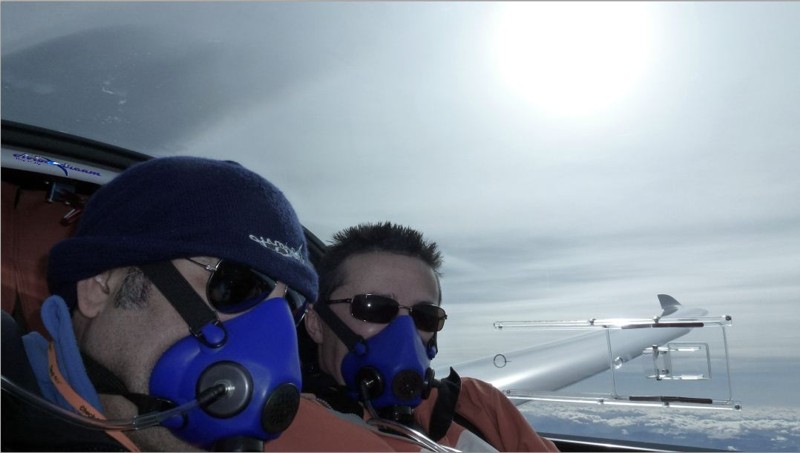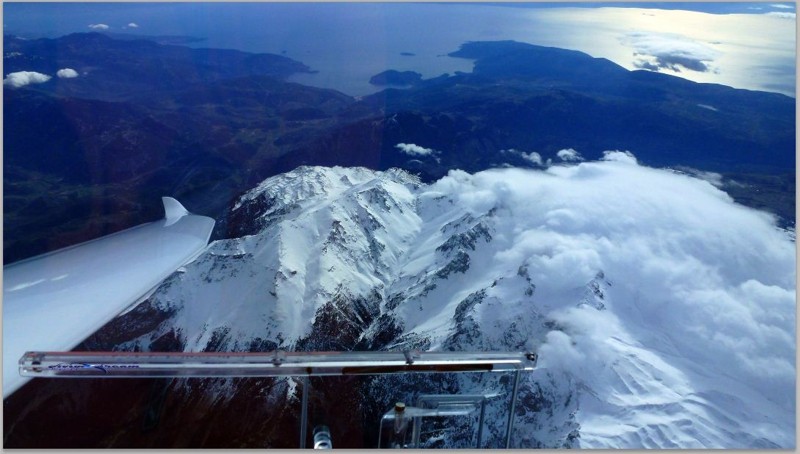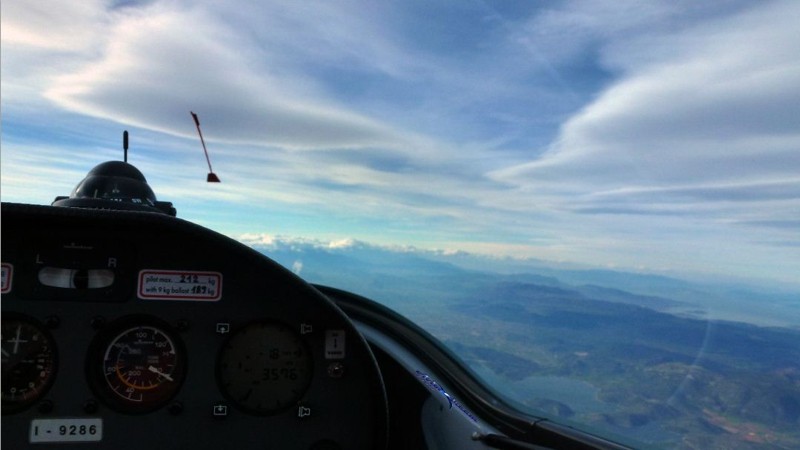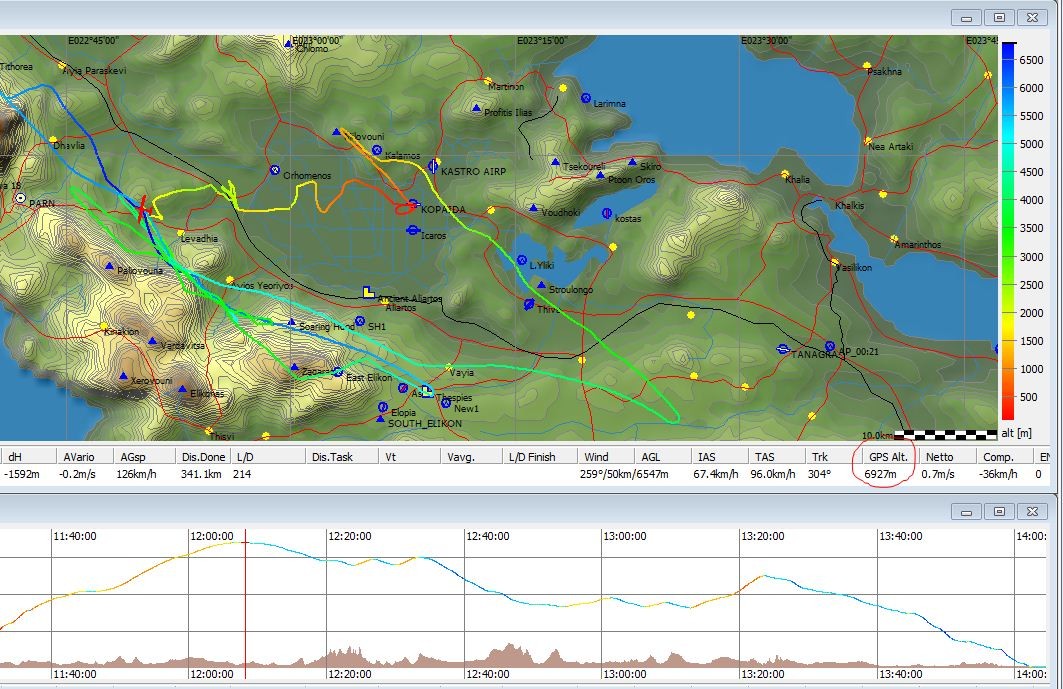Record Flight: Mike Anastasiou with Taurus to 6927 Meters of Altitude!
1st February 2013
In Greece during winter, very often we encounter a weather pattern (Nov. to April) where strong southwesterly winds associated with front passage create mountain wave over most Greek regions. The orographic terrain located almost at perfect angles to the wind direction usually 220 degrees to 260 degrees produce nice wave conditions.
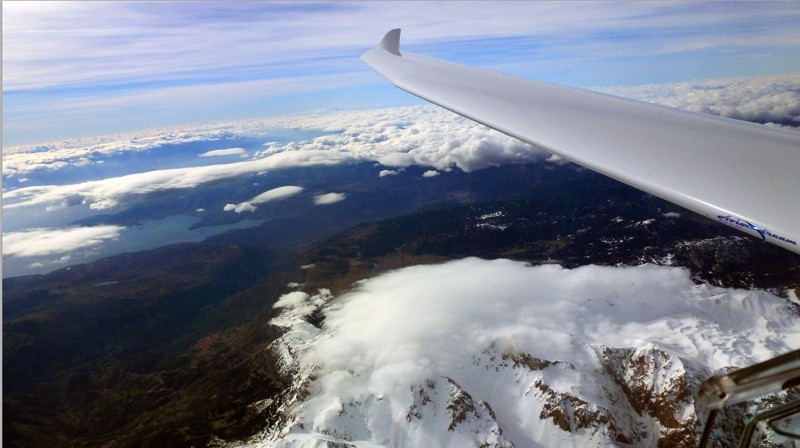
Humidity varies but mainly we get blue wave and most of the times we are capable of climbing higher than the lenticular clouds.
2nd February was a textbook day and we have been watching it closely from a week before. Although the wind direction was not perfect , westerly at 270 degrees, we would not miss the chance to stalk whatever wave was out there.
I arrived the night before. The caravan home at the airfield has been my shelter and a hub of endless talks during nights and non-flying days. With the heater on, I opened the flight sack and started emptying out all the gadgets, gear, cables, etc
One of the beds was totally covered with equipment. Took some time to rearrange all and place them in a priority status. The main electrical plug looked like an outlet from the movie Matrix . . . 2 PDAs HX4700 charging, Oudie (backup . . . can’t find the time to install it properly on the plane, but one day I will . . . I promise), portable radio, back-up cellphones, and a bunch of other gadgets necessary for the flight.
Most important for the flight is the O2.
Just received the O2D2 from Mountain High, upgraded and sealed in an airtight plastic bag. Show time (after the upgrade!) . . . Inserted 3 AA batteries, pressed the ON button and the unit started flashing and beeping, pulsing its valves with the familiar sound. Nice! System check ok.
Grabbed the 4-liter aluminum O2 bottle sitting on a shelf, closed the outlet and checked the pressure. 180 bars! Good for many hours of fan! The carbon 4-liter bottle can be on standby.
Completed checks of the O2 system by plugging in the Alpine full-face masks. Breathing on the ground in the Normal setting released no O2 but the pressure-activated valves of the unit were happily releasing.
Few years ago with the cannula masks we ‘suffered’ from lack of oxygen. No, it was not a problem of the mask. In engineering terms it is called RTFM (Read the f****n manual!) Not suitable above 18,000 ft. Still remember the experience when we had ‘clinically dead’ O2 levels in our blood vessels. Starting an emergency descent.
But now we are set to go with all the goodies in a more safe way! J
Checked latest tephigrams of tomorrow, confirming wind, temperature gradients, had a look at the satellite picture, and drove away to the local cult tavern with the BEST EVER beef steaks available on this planet (exaggeration, I know, but they feel like this when you are starving.)
Few hours later, like a full-of-food polar bear, turned off the lights in the caravan ‘mansion’, dreaming of the wave.
2nd February 2013 Wave day!
Half asleep jumped and opened the door looking at the mountains. It was 7 am. No wind on the ground, but the first signs of wave creation were showing up to the west.
Throwing some cold water on my face, run to the hangar and get the help of my friends to open the toy box.
In 15 minutes the Taurus was ready for the flight. Keeping it in tip-top shape pays out, as I know that every time the box opens, the toy is ready to play! It took more than an hour though to have it combat ready as we had to install all the gadgets and goodies in a routine, but also in a ceremonial, way.
A thorough preflight check of the Taurus revealed no problems or issues. Left the engine extended, checked the volts of the 2 batteries (when the plane sleeps in the trailer, I leave the solar panels do their magic, charging both batteries together as the solar charger controller permits.)
For the day, Thanos, a good friend and glider pilot, was joining on his first-ever wave experience.
He is late . . . I start getting uneasy as a Pipistrel Sinus already was transmitting the first info on the conditions. Then I took a second thought . . . we are not limited from daylight . . . we are O2 limited and the conditions are to get only better during the day. Relaxed and fiddled with my cellphone downloading visible satellite images and other stuff.
Thanos, my buddy, is finally here, bringing breakfast and coffee…
‘Leave the coffee aside . . . we drink it when we come back.’ But we need the food! I stored it in the vast space of Taurus while I was calling the local ATC for the flight plan.
The usual story with our ATC, that always makes me laugh.
ATC: Endurance and flight time Sir.
Me: 1 hour endurance and 6 hours flight time.
ATC: Is ok sir, you said the items reversed. I will fix the flight plan.
Me: No Madam, I have fuel for one hour and I will fly 6!
Takes a little bit more time to explain as they are not exposed to many glider flights. The only thing they control are the Mirage 2000 and the F16 of the base.
Putting on all the warm clothes, feeling like an onion, we sat in the Taurus, arranged all tubes, cables, oximeters and made a nice little cozy nest in which we will be sitting in for the next few hours. And most important, it had to be a turbulence-protected nest! You do not want your portable radio going through the canopy of the glider because you misjudged the descent rate and ended up in the rotors!
The Rotax 503 fired with the second attempt. Normal behavior until the fuel is re-established in the fuel lines. EGT and CHT start rising normally.
We start taxiing, holding the canopy open until we are at threshold. A western low-level wind was beneficial as we would depart with no turns. The clouds indicate winds around 30 kts. Not so strong.
Canopy closed and secured
Flaps T position
Final Clear
The Taurus did not need more than 150 meters to lift off. It was a nice day, giving us 3.5 m/s climb rate at full power.
15 minutes later we were approaching 2300 meters as we encountered many leeward updrafts and downdrafts.
Approaching from what it seems to be the second wave bar of the mountain, even at full power we got sink at 6 m/s! We ended up at 1400 meters! After that, we were in the upward stream of the wave bar.
Cooled the engine and stored it with a flick of a switch! Sooo easy . . . I feel spoiled!
Removed the headsets and started sniffing the area. Up to now not a single jolt! Nice. The Sinus earlier reported hard-core conditions! Where? Looked around and the only region I could see ‘battle zone’ was close to the summit of the mountain. Well I guess they wanted to be very brave.
The vario beeps at 4 m/s. A smooth, rapid climb. Reaching 4,000meters I decide to jump from the secondary wave bar to the front one.
Not many clouds or lenticulars in the area. A clear blue-wave day with some very high cirrus clouds allowing sunlight to warm the huge cockpit of the Taurus.
With flaps negative and close to True Air Speed Vne we attempt the jump. Although no turbulence encountered, the sink rate took a big toll on our altitude. Lost more than 2,000 meters in a mere 14 kilometer distance traveled. Wind at 80km/hr. headwind.
But the jump was worth it. Clean ascent with the vario pegged to 6.5 m/s. Had to reduce the volume of the vario as it became annoying. No bip bip . . . but a constant trtrtrtrtr . . .
Traveling back and forth on the first wave bar the altimeter was winding aggressively upwards.
Passing 4,500 meters we went on oxygen. One by one, we put on our face masks and turned the unit on. The oximeter jumped from 89% O2 to 97%. System is fine and we get the O2 we need.
Soon we reach the 6,000-meters mark. The vario is showing 3 m/s. I start to dislike it . . . did it die? The winds constant in strength at 85 km/hr. Using the see-you history we locate the sweet spot of the wave and return to it. It gave us a few extra meters.
The Taurus was sitting at 6,841 meters, 23,000 feet.
Smooth, and much less aerodynamic noise in the cockpit as the air density is less. Our breathing condensation formed some nice ice crystals on the top and the side of the canopy. Temperature at -16C.
The airliners cruising above at FL300 plus, looked so close now!
The vario is almost at zero but not negative. We have limited time up there as ATC has restricted us on altitude. Pulling the mask off, made a call to ATC for operations normal. The oximeter, permanent on my finger, is showing a healthy blood stream full of O2 . . . 98%!
Time to use the altitude for some cross country kilometers. Heading southeastbound the ground speed was showing more than 270km/hr. Nice! But we will be crawling on the way back. Who cares! We just achieved the new height mark for the Taurus . . . the rest is just fun!
The high cirrus were getting more dense. The front was approaching from the southwest. Maintaining an average of 5,000 meters we went for a 5-turning-point pattern concentrating in a higher speed cruising leaving the flaps at negative all the time.
My friend spots an Olympic Air Bombardier Q400 turboprop at 2 o’clock a few miles from us and about a thousand feet high. It looked so close, but air traffic control has been aware!
Do you think they can see us?
Turning on the final point with the day giving ample lift if you knew where to get it, we went for the final glide back to our base.
A smooth touch with half speed brakes and the Taurus came to a stop in front of the hangar.
Opening the canopy, the first thing to do was to call the ATC and close the flight plan, thanking them for their great support and cooperation.
Shook hands with each other and unfolded our bodies crawling out. The air on the ground felt and smelled almost like spring!
Fellow glider and other pilots approached to help us push the Taurus in the hangar. Their first question was : How HIGH!!!???? With a humble voice, I whispered the number.
Left my friend to clean the glider, with almost nothing to clean as no bugs will stick at 23,000 ft. and at -16 Celsius. Run to fetch my computer and analyze the flight.
Final true altitude reached was 6,927 meters!
Run back to the glider and announce the analysis . . . happily cost me the dinner in the tavern!
Preparing the glider for the next day with a forecast of jetstream winds, we continued the hangar talk.
The heavy doors of the hangar closed at dusk and we headed for the ceremonial grilled steaks.
2nd of February of 2013 was a really good day for us!
The next day started with wind gusts of more than 50 kts. on the ground. The coming front destabilized the upper atmosphere and there was no wave formation. Rotor clouds everywhere with high humidity. ‘ It must be hell today up there.’ The forecast was giving 100 kts. at 3,000 meters.
Analyzing the weather for about 3 hours, we ended up having a long coffee session and airplane talk.
It took 20 minutes later on to disassemble and place the Taurus in its trailer.
Until next time . . .
Keep your gadgets always ready and charged!
Michail Anastasiou
Kopaida Airfield
Athens
Greece
PS 1: The Sinus on the 2nd of February reached 6,500 meters! They were limited by the O2 system they had . . . otherwise???
PS 2: Thanos, the other pilot, said some point in the flight: This is wave flying? Is so easy and smooth! I can’t believe it. I hear horror stories.
I replied: Well, what you saw today was accumulated experience. But believe me, in order to get to the experience level required, you have to be in the horror stories you heard. To be in them at least once!

